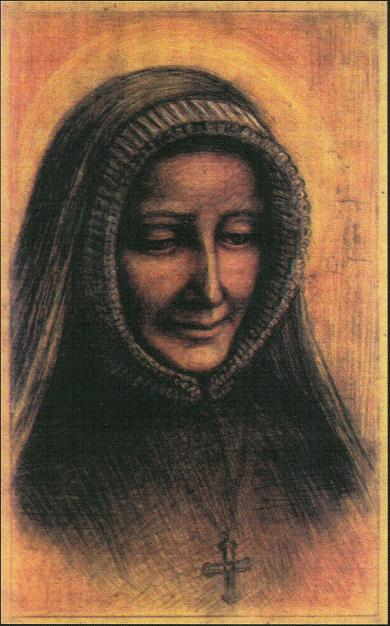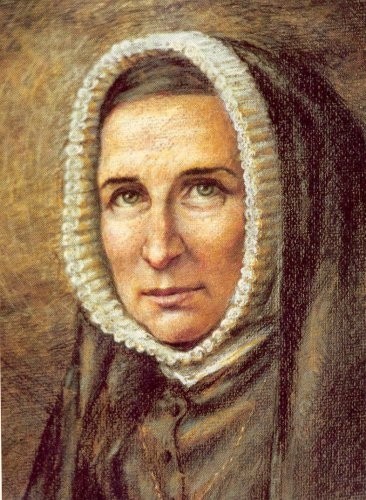 Saint Madeleine Sophie Barat (1779-1865)
Saint Madeleine Sophie Barat (1779-1865)
Madeleine-Sophie Barat was born in 1779, daughter of a wine cooper in the little Burgundian town of Joigny in France. After an extraordinary education by her priest brother, she went with him to Paris in 1795 to complete her training. There on November 21, 1800, Madeleine Sophie and three other young women consecrated themselves to the Sacred Heart of Jesus. In 1806, she was elected superior general and became the cornerstone of the Society of the Sacred Heart, whose purpose was to make known the love of God revealed in the Heart of Christ, and to take part in the restoration of Christian life in France through the education of young women.
The Society of the Sacred Heart quickly expanded within Europe and beyond. At the same time, Sophie Barat learned to counterbalance her learned view of God as a harsh judge with her experience of the love of God revealed in the Heart of Christ. Her natural capacity for friendship enabled a wide network of relationships. Her awareness of world events and their impact on education ensured the Society’s contribution to the promotion of women in her time and into the future. Her style of leadership tended towards consultation rather than decree, and to accepting the realistic option, rather than the impossible ideal. This consultative approach is evident in her letters to those members of the Society in the United States who wrote to her in the 1820s and 30s requesting — and, unfortunately, receiving — her permission and support to become slaveholders. Her model of leadership through relationships was tested several times, especially from 1806 to 1815 and 1839 to 1851.
Her habit of a deep life of prayer and reflection, consistently found in her 14,000 extant letters, was stressed in the original Constitutions of the Society of the Sacred Heart of 1815 and reaffirmed in the revised Constitutions of 1982. It remains a vital legacy to the Society and to the wider Christian community.
At the time of her death on May 25, 1865, Sophie Barat was guiding an international community of over 3,000 women, which today extends to 41 countries.
No authentic portrait of Sophie Barat exists from her lifetime, since she refused to allow her photograph to be taken. A photograph taken on her deathbed became the source of several later portraits.
Madeleine Sophie Barat was canonized a saint of the Roman Catholic Church on May 25, 1925. Her feast is kept on May 25.
 Saint Rose Philippine Duchesne (1769-1852)
Saint Rose Philippine Duchesne (1769-1852)
Rose Philippine Duchesne was born in Grenoble, France, on August 29, 1769, into a family actively involved in political and commercial life. Educated by the Visitation nuns at Sainte Marie d’en Haut monastery, she was drawn to their life of contemplation. She entered the congregation when she was 19, against the wishes of her family.
The French Revolution soon forced the nuns to leave the monastery, and Philippine returned to her family. For 11 years, she risked her freedom and life by nursing prisoners, bringing priests to the faithful, and teaching and feeding poor children. At the close of the war, she gained title to Sainte Marie d’en Haut and opened a boarding school. In December 1804, she met Madeleine Sophie Barat, who in 1800 had founded the Society of the Sacred Heart. Philippine immediately turned over Sainte Marie d’en Haut and entered the Society.
A deep friendship formed between these two remarkable women of such different temperaments. For 12 years, the patient wisdom of Sophie molded the ardent, steadfast Philippine into a religious called to glorify the Heart of Jesus. Philippine, whose greatest joy was to spend whole nights in prayer, soon felt a call to serve as a missionary. Many times, Philippine shared with Sophie her dream of bringing the Gospel to the native peoples in America, but her skills were needed at home, first in the school at Sainte Marie, and from 1815 as the Society’s secretary general.
Her dream was realized when Sophie accepted Bishop William Du Bourg’s invitation to establish schools for the Native Americans and French children in the diocese of Louisiana. Philippine Duchesne, Eugénie Audé, Octavia Berthold, Marguerite Manteau, and Catherine Lamarre set sail for North America on the Rebecca, March 21, 1818, landing near New Orleans on the Feast of the Sacred Heart, May 29, 1818, and from there they traveled to St. Louis, Missouri.
At the direction of Bishop Dubourg, Philippine and her companions went to St. Charles, Missouri, across the Missouri River, where on September 14, 1818, they opened the first Sacred Heart school outside of Europe. It was also the first free school west of the Mississippi and the first Catholic school in what would become the Saint Louis archdiocese. By the next year, they relocated to Florissant, Missouri, where in 1820, Mother Duchesne opened the first novitiate. Other schools soon followed in Missouri and Louisiana. Eventually there were six schools.
During this period, Philippine also made the decision to involve the Society in the institution of slavery, with the support of Sophie and the encouragement of other Catholic religious orders and clergy, as well as her local bishops. The eventual success of the schools founded in that time is due in no small part to the many enslaved people whose forced labor built and maintained them. (Much work is being done in the United States – Canada Province today to uncover the truth about this shameful part of our history, taking responsibility for the grievousness of the sin committed, and taking steps towards a process of repair and reconciliation. Read more here.)
In 1841, Philippine and three other Religious of the Sacred Heart went to Sugar Creek, Kansas, to establish a school for Potawatomi girls. At 72, too frail to do physical work, and unable to learn the Potawatomi language, she spent much of her time in prayer, gaining the name “Woman Who Is Always Praying.” After just one year, she was recalled to St. Charles, her original foundation, where she died on November 18, 1852, at age 83, having spent 34 years in America.
It was later admirers of Philippine who initiated her process of canonization in the Catholic Church. She was declared a saint of the Catholic Church in 1988. Her Feast Day is November 18.
